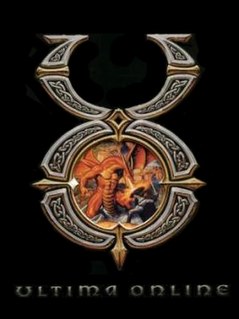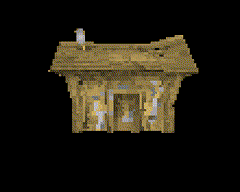
Ultima Online (UO) is a massively multiplayer online role-playing game (MMORPG) released on September 24, 1997 by Origin Systems.

Bleem! was a commercial PlayStation emulator released by the Bleem Company in 1999 for IBM-compatible PCs and Dreamcast. It is notable for being one of the few commercial software emulators to be aggressively marketed during the emulated console's lifetime, and was the center of multiple controversial lawsuits.
GLX is an extension to the X Window System core protocol providing an interface between OpenGL and the X Window System as well as extensions to OpenGL itself. It enables programs wishing to use OpenGL to do so within a window provided by the X Window System. GLX distinguishes two "states": indirect state and direct state.
Source is a 3D game engine developed by Valve. It debuted as the successor to GoldSrc with Counter-Strike: Source in June 2004, followed shortly by Half-Life 2 in November, and has been in active development since. Source does not have a concise version numbering scheme; instead, it is designed in constant incremental updates. The successor, Source 2, was officially announced in March 2015, with the first game to use it being Dota 2, which was ported over from Source later that year.

The S3 Virtual Reality Graphics Engine (ViRGE) graphics chipset was one of the first 2D/3D accelerators designed for the mass market.
Cairo is an open source programming library that provides a vector graphics-based, device-independent API for software developers. It provides primitives for two-dimensional drawing across a number of different back ends. Cairo uses hardware acceleration when available.

Ultima II: The Revenge of the Enchantress, released on August 24, 1982 for the Apple II, is the second role-playing video game in the Ultima series, and the second installment in Ultima's "Age of Darkness" trilogy.

The Direct Rendering Infrastructure (DRI) is a framework for allowing direct access to graphics hardware under the X Window System in a safe, efficient way. The main use of DRI is to provide hardware acceleration for the Mesa implementation of OpenGL. DRI has also been adapted to provide OpenGL acceleration on a framebuffer console without a display server running.

Ultima Online: Third Dawn, released in 2001, introduced 3D models to the Ultima Online MMORPG franchise. While the game still maintained its scaled, overhead view, the character animation was much smoother. With the introduction of the Ultima Online: Kingdom Reborn client, the Third Dawn client is obsolete, and no longer usable on official shards.

Software rendering is the process of generating an image from a model by means of computer software. In the context of computer graphics rendering, software rendering refers to a rendering process that is not dependent upon graphics hardware ASICs, such as a graphics card. The rendering takes place entirely in the CPU. Rendering everything with the (general-purpose) CPU has the main advantage that it is not restricted to the (limited) capabilities of graphics hardware, but the disadvantage that more semiconductors are needed to obtain the same speed.

Microsoft Flight Simulator X is a 2006 flight simulation video game originally developed by Aces Game Studio and published by Microsoft Game Studios for Microsoft Windows. It is the sequel to Microsoft Flight Simulator 2004 and the tenth and most current installment of the Microsoft Flight Simulator series, which was first released in 1982. It is built on an upgraded graphics rendering engine, showcasing DirectX 10 features in Windows Vista and was marketed by Microsoft as the most important technological milestone in the series to date. FSX is the first version in the series to be released on DVD media.
The history of massively multiplayer online games spans over thirty years and hundreds of massively multiplayer online games (MMOG) titles. The origin and influence on MMO games stems from MUDs, Dungeons & Dragons and earlier social games.
Sun Visualization System was a sharable visualization product introduced by Sun Microsystems in January 2007. It used other Sun technologies, including Sun servers, Solaris, Sun Ray Ultra-Thin Clients, and Sun Grid Engine. The Sun Visualization System software was based on several open source technologies: Chromium to perform distributed 3D rendering, VirtualGL to re-route 3D rendering jobs to arbitrary graphics devices, and TurboVNC to deliver the rendered 3D images to a client or clients. Sun sponsored and/or contributed changes back to these projects throughout the life of the Sun Visualization System.
Clesh is a cloud-based video editing platform designed for the consumers, prosumers, and online communities to integrate user generated content. The core technology is based on FORscene which is geared towards professionals working for example in broadcasting, news media, post production.
Blue Mars was a 3D massively multiplayer virtual world platform beta. The platform, being developed by Hawaii-based Avatar Reality, allows 3rd parties to create virtual worlds, MMOG games, simulations, shops, businesses, entertainment venues, clothing, custom avatars, furniture, virtual homes, and other items. It consists of four main parts: the client software, the Sandbox Editor SDK suite, the website, and the host servers. It is often compared to Second Life, since both are virtual social worlds allowing user-created content. According to Jim Sink, CEO of Avatar Reality, "Blue Mars was inspired by a vision of the future when the power to terraform whole worlds is within our grasp. The name Blue Mars represents possibility and hope."

Vaadin is an open-source platform for web application development. The Vaadin Platform includes a set of web components, a Java web framework, and a set of tools and application starters. Its flagship product, Vaadin Platform allows the implementation of HTML5 web user interfaces using the Java Programming Language.
Isometric video game graphics are graphics employed in video games and pixel art which angle the viewpoint to reveal facets of the environment that would not be visible from a top-down perspective or side view, thereby producing a three-dimensional effect. Despite the name, isometric computer graphics are not necessarily truly isometric—i.e., the x, y, and z axes are not necessarily oriented 120° to each other. Instead, a variety of angles occur; some form of parallel projection, such as dimetric projection with a 2:1 pixel ratio, is the most common. The terms "3/4 perspective", "2.5D", and "pseudo-3D" are also sometimes used, although these terms can possess slightly different meanings in other contexts.

Voreen is an open-source volume visualization library and development platform. Through the use of GPU-based volume rendering techniques it allows high frame rates on standard graphics hardware to support interactive volume exploration.
Wolfenstein: Ray Traced is a research project from Intel Corporation that applied a ray tracing renderer to the game content of Wolfenstein (2009). The possibility of using ray tracing for this game in real-time has been demonstrated with a cloud-based rendering approach.
JWt is an open-source widget-centric web application framework for the Java programming language developed by Emweb. It has an API that uses established GUI application development patterns. The programming model is component-based and event-driven, similar to Swing.











